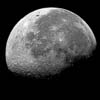Courtesy of EarthSky
A Clear Voice for Science
Visit EarthSky at
www.EarthSky.org

 The constellation Hercules the Kneeling Giant can be seen ascending in the east-northeast on these spring evenings. Our chart today shows the sky for late night, when all of these objects are well up in the northeastern to eastern sky.
The constellation Hercules the Kneeling Giant can be seen ascending in the east-northeast on these spring evenings. Our chart today shows the sky for late night, when all of these objects are well up in the northeastern to eastern sky.
The stars Arcturus and Vega can help you identify Hercules, whose most noticeable pattern is a squarish figure in the center of the constellation. This sky pattern, or “asterism,” is known as the Keystone in Hercules.
The Keystone is a helpful pattern for more reasons than one. First, it is noticeable on the sky’s dome, so can lead your eye to Hercules. In addition, the Keystone in Hercules can help you find the most fascinating telescopic object within the boundaries of this constellation. This object is a globular star cluster. Known to stargazers as M13 or the Great Cluster in Hercules, it is barely visible the eye alone in the darkest of skies.
More on M13: Great cluster in Hercules
Binoculars show M13 as a nebulous patch. However, telescopes show stars both on the periphery of the cluster and toward its center. For a picture of M13 from the NOAO Image Gallery, look here.
This beautiful object is one of the galaxy’s oldest inhabitants. It is a tightly packed spherical collection of about one million stars.
By Deborah Byrd
Astronomy Picture of the Day from NASA/JPL
U.S. Naval Observator Astronomical Information center
The York County Astronomical Society